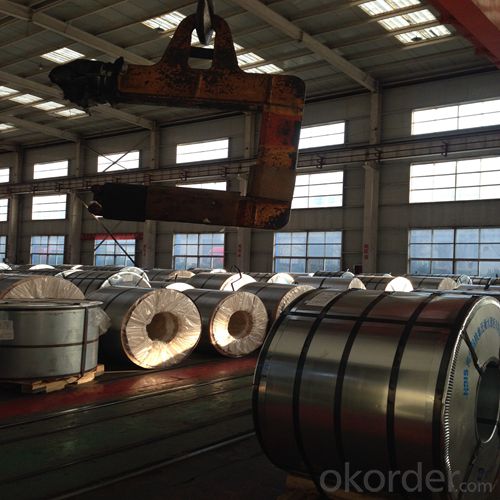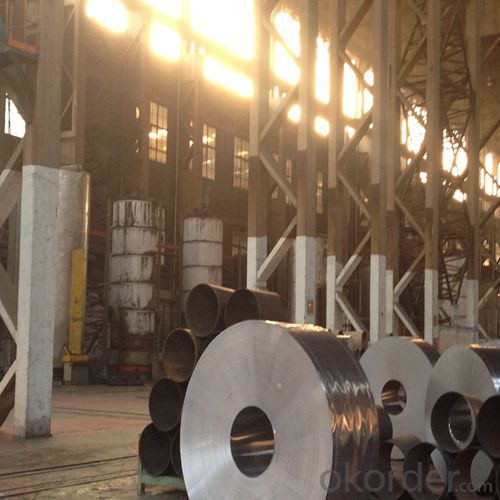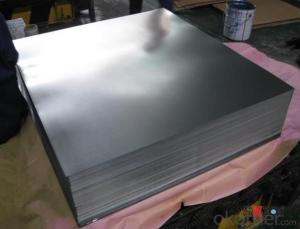Tinplate (ETP) Coil and Sheets for Foods Packaging
- Loading Port:
- Tianjin
- Payment Terms:
- TT OR LC
- Min Order Qty:
- 25 m.t.
- Supply Capability:
- 7000 m.t./month
OKorder Service Pledge
OKorder Financial Service
You Might Also Like
1.Structure of Tinplate (ETP) Coil and Sheets for Foods Packaging Description
Electrolytic Tin Plate Coils and Sheets for Foods Metal Packaging, is one thin steel sheet with a coating of tin applied by electrolytic deposition. Tinplate made by this process is essentially a sandwich in which the central core is strip steel. This core is cleaned in a pickling solution and then fed through tanks containing electrolyte, where tin is deposited on both sides. As the strip passes between high-frequency electric induction coils, it is heated so that the tin coating melts and flows to form a lustrous coat.
2.Main Features of the Tinplate (ETP) Coil and Sheets for Foods Packaging
Appearance – Electrolytic Tin Plate is characterized by its beautiful metallic luster. Products with various kinds of surface roughness are produced by selecting the surface finish of the substrate steel sheet.
Paintability and printability – Electrolytic Tin Plates have excellent paintability and printability. Printing is beautifully finished using various lacquers and inks.
Formability and strength – Electrolytic Tin Plates have got very good formability and strength. By selecting a proper temper grade, appropriate formability is obtained for different applications as well as the required strength after forming.
Corrosion resistance – Tinplate has got good corrosion resistance. By selecting a proper coating weight, appropriate corrosion resistance is obtained against container contents. Coated items should meet 24 hour 5 % salt spray requirement.
Solderability and weldability – Electrolytic Tin Plates can be joined both by soldering or welding. These properties of tinplate are used for making various types of cans.
Hygienic – Tin coating provides good and non toxic barrier properties to protect food products from impurities, bacteria, moisture, light and odours.
Safe – Tinplate being low weight and high strength makes food cans easy to ship and transport.
Eco friendly – Tinplate offers 100 % recyclability.
Tin is not good for low temperature applications since it changes structure and loses adhesion when exposed to temperatures below – 40 deg C.
3.ETinplate (ETP) Coil and Sheets for Foods Packaging Images



4.Tinplate (ETP) Coil and Sheets for Foods Packaging Specification
Standard | ISO 11949 -1995, GB/T2520-2000,JIS G3303,ASTM A623, BS EN 10202
|
Material | MR,SPCC |
Thickness | 0.15mm - 0.50mm |
Width | 600mm -1150mm |
Temper | T1-T5 |
Annealing | BA & CA |
Coil Inner Diameter | 508mm |
Weight | 6-10 tons/coil 1~1.7 tons/sheets bundle |
Passivation | 311 |
Oil | DOS |
Surface | Finish,bright,stone,matte,silver |
5.FAQ of Tinplate (ETP) Coil and Sheets for Foods Packaging
- How are the Electrolytic Tin Plates specified?
The Electrolytic Tin Plates are specified as per the steel base, extent of tempering, the coating weight, annealing method and the surface finish.
- How many types there are for base steels?
The base steels are of three types: Type MR, L, D
- Q:How does tinplate handle exposure to gases and odors?
- Tinplate is highly resistant to gases and odors, making it an excellent choice for packaging materials. It provides a reliable barrier that prevents the transfer of gases and odors, ensuring the preservation and protection of the contents.
- Q:What details should I pay attention to when purchasing tinplate packing boxes?
- Many small processing plants or small factories can accept the buyer's bargaining, but the iron is really not flattering. In fact, the market is very transparent iron materials, buyers do not mean that the more the better the bargaining, but to understand the market, do not bargain.
- Q:Can tinplate be used for art and sculptures?
- Yes, tinplate can be used for art and sculptures. Its malleability and durability make it a suitable material for creating various artistic forms and sculptures. Additionally, tinplate can be easily manipulated, painted, and decorated, allowing artists to explore their creativity and produce unique artworks.
- Q:How does tinplate packaging contribute to product aesthetics?
- Tinplate packaging contributes to product aesthetics by providing a visually appealing and attractive presentation. The shiny and smooth surface of tinplate enhances the overall look of the packaging, giving it a premium and high-quality feel. Additionally, tinplate allows for intricate designs, embossing, and printing techniques, allowing brands to create eye-catching graphics and logos that further enhance the visual appeal of the product.
- Q:How does tinplate perform in terms of light blocking properties?
- Tinplate has excellent light blocking properties due to its opaque nature, making it an effective material for preserving the quality and freshness of light-sensitive products.
- Q:What are the different types of tinplate closures available?
- There are several types of tinplate closures available, including twist-off caps, crown caps, lug caps, and screw caps.
- Q:What are the different types of tinplate?
- There are three main types of tinplate: Single Reduced (SR), Double Reduced (DR), and Electrolytic Chromium Coated Steel (ECCS).
- Q:How is tinplate priced?
- Tinplate is typically priced based on various factors including market demand, production costs, and quality of the tin coating. Additionally, market fluctuations and trade policies can also affect the pricing of tinplate.
- Q:Can tinplate packaging be used for aerosol products?
- Yes, tinplate packaging can be used for aerosol products. Tinplate is a commonly used material in aerosol can production due to its durability, resistance to corrosion, and ability to withstand the pressure exerted by aerosol content. Additionally, tinplate cans can be easily shaped and decorated, making them suitable for various aerosol products in the market.
- Q:What are the advantages of using tinplate for shipping containers?
- There are several advantages of using tinplate for shipping containers. Firstly, tinplate is highly durable and provides excellent protection against corrosion and oxidation, ensuring the contents of the container remain safe during transit. Secondly, tinplate is lightweight yet strong, allowing for easier handling and reducing transportation costs. Additionally, tinplate is easily recyclable, making it a sustainable choice for shipping containers. Lastly, tinplate offers a smooth surface which is conducive to branding and can be easily customized with logos and designs, enhancing the overall aesthetic appeal of the container.
1. Manufacturer Overview |
|
|---|---|
| Location | |
| Year Established | |
| Annual Output Value | |
| Main Markets | |
| Company Certifications | |
2. Manufacturer Certificates |
|
|---|---|
| a) Certification Name | |
| Range | |
| Reference | |
| Validity Period | |
3. Manufacturer Capability |
|
|---|---|
| a)Trade Capacity | |
| Nearest Port | |
| Export Percentage | |
| No.of Employees in Trade Department | |
| Language Spoken: | |
| b)Factory Information | |
| Factory Size: | |
| No. of Production Lines | |
| Contract Manufacturing | |
| Product Price Range | |
Send your message to us
Tinplate (ETP) Coil and Sheets for Foods Packaging
- Loading Port:
- Tianjin
- Payment Terms:
- TT OR LC
- Min Order Qty:
- 25 m.t.
- Supply Capability:
- 7000 m.t./month
OKorder Service Pledge
OKorder Financial Service
Similar products
New products
Hot products
Hot Searches
Related keywords





























